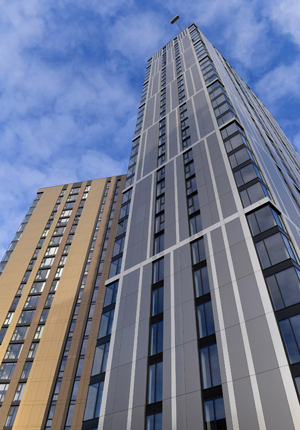Leading construction accessories manufacturer, Leviat, announces the release of its new Ancon Staifix HRT4 300mm Wall Tie designed for use in wider walls with cavities ranging from 151-175mm. The addition of this product to the existing range will help specifiers and builders to meet the latest Part L regulations and achieve the more stringent U-values and building fabric requirements in the upcoming Future Homes Standard.
Developed with both performance and compliance in mind, the new wall tie has been rigorously tested and certified, bearing both the CE and UKCA markings that reassure builders of its quality and adherence to safety standards. Additionally, the product complies with Part E of the Building Regulations as a Type A wall tie, which qualifies it for use in internal party walls, enhancing its versatility and applicability across various construction projects.
The introduction of this new wall tie comes as the construction industry prepares for the transition towards more energy-efficient and sustainable building methods. With the Future Homes Standard on the horizon, it is essential for builders and contractors to utilise materials and technologies that will contribute to creating homes with low carbon emissions and high energy savings.
Key features and benefits of the new 300mm Type 4 wall tie include: ·
- Compatibility with wider cavity walls (151-175mm), offering greater flexibility in design and construction·
- Type 4 performance to PD 6697:2019 making it suitable for external walls of domestic buildings up to 10m in height·
- Aids compliance with Part L of the Building Regulations and provides readiness for the Future Homes Standard, ensuring long-term viability and performance·
- Third party tested and UKCA & CE marked – a testament to product quality and safety·
- Suitable for use in internal party walls as a compliant Type A wall tie to Part E of the Building Regulations.
Rory Ashcroft, National Sales Manager for Merchants said:
“We are proud to introduce this wall tie to the market, which shows our commitment to innovation and excellence in the building industry and not only meets today’s standards but also paves the way for a more sustainable future. This new wall tie is a testament to that dedication, and we are confident it will significantly benefit our customers.”
The new Ancon Staifix HRT4 300mm Wall Tie is now available through a large network of builders’ merchants. Builders and architects looking to ensure their projects are future-proofed and energy-efficient are encouraged to explore this new offering and its many advantages.
CLICK HERE for more information about this new cavity wall tie
CALL 0114 238 1238
OR CLICK HERE TO EMAIL US





 Glancy Nicholls’ Marketing Co-ordinator Sophie Casewell said: “We specified the Kawneer systems for their system performance, particularly in relation to wind loads.
Glancy Nicholls’ Marketing Co-ordinator Sophie Casewell said: “We specified the Kawneer systems for their system performance, particularly in relation to wind loads.
